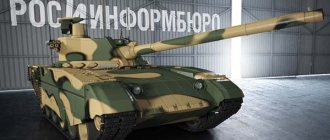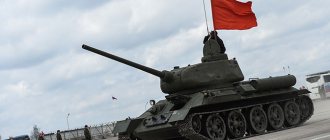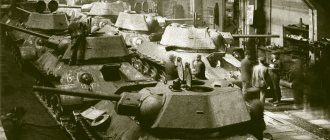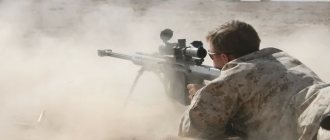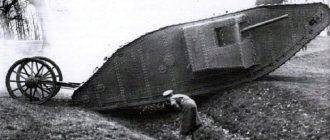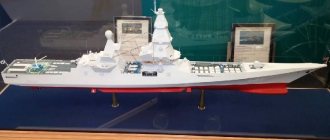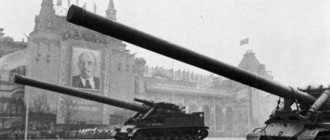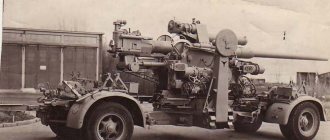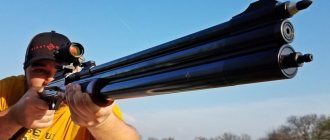The Second World War spurred progress in tank building. In just six years, tanks have made a greater leap than in the previous twenty. A significant part of the tanks acquired projectile-proof armor, powerful long-barreled guns with a caliber of up to 152 mm (for the KV-2), at the end of the war the first night - infrared - sights appeared (although experiments on installing them on tanks were carried out in the USSR even before the war), radio equipment for tanks became be considered necessary. The tactics of using tanks also reached a high degree of perfection - in the first period of the war (1939-1941), German military leaders demonstrated to the whole world how the use of tank formations makes it possible to carry out operations for operational and strategic encirclement and the subsequent defeat of large enemy military groups and quickly win the war ( so-called “blitzkrieg”). However, other states (Great Britain, France, Poland, the USSR, etc.) created their own doctrines of tactics for using tanks, in many ways similar to the German one. During World War II, the German tank building school relied on increasing the armor and length of guns, improving surveillance devices (including infrared night vision devices), and improving habitability. The Soviet school focused primarily on manufacturability and mass production, making major changes to the design of basic types of tanks (T-34, KV and IS) only when absolutely necessary. The Soviet tank building school also created quite successful models of other types of armored vehicles, self-propelled artillery units and tank destroyers. The American school, with some initial backwardness in terms of layout and technology, nevertheless made up for lost time by the end of the war due to the deployment of mass production of several selected models, good quality steel and gunpowder, as well as radio equipment (at least two radios per tank). The most successful German tanks were the PzKpfw IV (the most popular), the Tiger, and, with some reservations, the Panther and the Royal Tiger [source not specified 348 days]. The best Soviet tanks that participated in World War II were recognized as the T-34 medium tank (in different versions, including its later version T-34-85 with various modifications of 85-mm guns) and the IS-2 heavy tank. The M4 Sherman, which was widely supplied to the USSR under Lend-Lease, was recognized as the best American tank.
More stuff
2017 Germany, France, Russia / Germany, France, Russia Format / Format: Documentary series / Documentary series (HD) Genre / Genre: history, science, war, biography / historical, science, military, biography Run time / Timing: 4 x 43'/52'
The early twentieth century was an era of enlightenment, progress and peace: telephones and telegraphs, automobiles, railways and iron ships connected people around the world. The likelihood of war in Europe seemed a thing of the distant past - for more than 30 years there had been no armed conflicts in the heart of modern civilization, nothing foreshadowed a new war, but the peace was broken in the summer of 1914. The war began again, and it was more terrible than all previous wars, because under the cover of peace and progress, other, deadly forms of technology were developed. The war filled the outskirts of Flanders with blood. Machine guns, barbed wire, trenches and artillery - a huge death machine consumed thousands of people. In its desperation, humanity again turned to technology. Inventors and engineers sought to find a way out - a path to victory, because victory was a way to stop the meat grinder. Many types of weapons were invented then, but one in particular stands out. Over the next hundred years, it will become the main tool for depersonalizing war, but will still excite the minds of boys and grown men. This is a tank. The documentary series explores the history of the most iconic and feared weapons of the 20th century. The series will show what it was like to design, build, use and suffer from these fighting machines, through the eyes of the people behind the tanks. Available in: Russia, CIS
The history of the 20th century, as seen through its tanks. The world was crumbled in the summer of 1914. War had come again – and more terrifying than ever before. In its desperation, humanity turned to technology once more. Inventors and engineers strove to find a way out – a way to victory, and, through victory, a way to end the killing. Of the many weapons conceived at that time, one stands out. Over the course of the next century, it would stand like no other for dehumanized warfare and oppression, and yet would fascinate boys and men, and even star in big Hollywood movies. This weapon is the tank. In this series, we re-trace the history of what is perhaps the most iconic and terrifying weapon of the 20th century over the course of four episodes. We discover what it was like to design, build, operate, and suffer from these war machines – by telling the stories of the people behind the tanks. Available territories: Russia, CIS
The worst tanks of WORLD WAR II
The worst tanks of the Second World War
People love to talk about the best tanks. This is a great discussion - there are many complex technologies in the military world, each with their own strengths and weaknesses. However, we rarely talk about the other side of this coin: which equipment can be considered the worst?
There are some fighting vehicles whose sole purpose is to serve as an example of what not to do.
do. So let's dive in without limits and look at the very worst the world of tank building has to offer.
10.Type 95 Ha-Go.
Japan's greatest victories in this era tended to come from its air and naval forces, and for good reason. The Army itself produced very few truly good ground weapons of war, and the development of their armored corps barely went beyond a few light tanks and the Type 95 was no exception.
It is worth noting that the tank was made to fight forces made close to the Middle Ages. China was not exactly a technological power at the time, and most of its military tended to consist of small bands of poorly armed militias, most armed with pistols or swords. Because of this, the vehicle was made with thin armor and, although fast-firing, it was not the most powerful, and also far from accurate. While it was certainly fast and well suited to harsher tropical conditions such as Malaya, these strengths were offset by various mechanical failures and a number of extremely unreliable and temperamental engine problems.
While the M3 Stuart remained the best allied tank in the Pacific Ocean, the Ha-Go could still somehow fight them, although the American tank had much better armor, which protected it well from the fire of weak Japanese guns. But the new M4 Sherman tanks, which appeared in 1943, turned out to be practically invulnerable to Ha-Go guns, even at extremely short distances.
9.
Matilda I
While certainly not as bad as some of the later examples on this list, the Matilda is unlikely to be a car that will be remembered with any reverence. An oddity of its era and a relic of the crude designs of the 1930s, it featured a rather inappropriate combination of armor and weaponry. It was a heavily armored tank whose only offensive weapon was a machine gun. As you might imagine, this left them rather ill-equipped to deal with certain threats, especially armored positions and vehicles, and the heavily exposed tracks and undercarriage made the tank relatively easy to immobilize. Additionally, due to the relatively compact design, each crew member had to perform multiple duties simultaneously. It was assumed that, along with controlling the vehicle, the commander would simultaneously serve as a radio operator, gunner and loader, while the driver was simply supposed to deliver the tank from point A to point B. And as a bonus, the speed of movement was 8 miles per hour.
8. Heavy Tank KV-2 - Clumsy Beast
At first glance, the KV-2 may seem like a powerful and intimidating machine, but on the battlefield it was easy prey for the enemy.
Taking the existing platform of the KV-1 heavy tank as a basis, adding a box-shaped turret and a massive 152-millimeter howitzer capable of firing 40-kilogram high-explosive fragmentation shells, the KV-2 was powerful only in theory. In reality, the tank was slow and had poor maneuverability, the gun took a long time to reload, the massive turret was subject to unmasking, and the presence of ammunition in it only made the tank more vulnerable.
All this made the KV-2 (log launcher) virtually useless against the invading German troops, who were equipped with new high-rate-of-fire guns capable of penetrating the KV-2's turret armor.
7.
Panzerkampfwagen Tiger Ausf. B (Tiger II)
While the Tiger I is often notorious for being problematic and over-engineered, it at least had the element of surprise and few competitors. By the time II (the second) rolled off production lines, Germany was in serious trouble, and tactics had been developed to counter it. They were rushed into service, but were hampered by poorly trained crew members and suffered from noticeable design flaws. Too big for railroad cars and too heavy for bridges, an extremely overstressed drive train that was never designed for something of the size and weight of such a machine, and a double-radius steering gear that was extremely prone to failure. Even when they engaged in battle, armor was surprisingly lacking. While the metal was definitely thick and well angled, it was quite brittle and the seams would either crack or splinter under repeated impacts. To the Tiger's credit, despite this glaring flaw, it can be added that it was not confirmed that the tank was destroyed by enemy armored vehicles. Instead, most were often found abandoned due to fuel consumption problems as they ran dry before they could return to storage.
While many of these problems were admittedly gradually overcome over time, they required extensive maintenance and problematic reliability that plagued them until the end of the war. Ultimately, Tiger II truly lived up to its name. It was twice the tank that the Tiger I was, with twice as effective armor, and twice as many problems as its predecessor.
6.T-26
In many publications you can now find information about the enormous superiority of Soviet troops over German troops at the very beginning of World War II and the colossal total number of tanks in the USSR by the summer of 1941 - more than 25 thousand vehicles. However, it is often not specified what type of tanks formed the basis of this armada.
The main battle tank of the Red Army was the T-26 light tank. In 1931-1933 It was produced in a version with two turrets and only with machine gun armament, representing not the most effective combat unit. In total, more than 1,600 units of this weapon were produced. Since 1933, the T-26 began to be produced with one turret and cannon and machine gun armament. It was produced until 1941, when the outbreak of war showed its complete unsuitability. More than 11 thousand units of equipment were produced. Thus, almost half of the USSR tanks in the summer of 1941 were these vehicles.
The tank was intended for fire support of infantry and was not suitable for breakthroughs as part of large tank formations.
Please note: The most pleasant medium tanks are level 6 (part 2)..
It was slow-moving with a maximum speed of 30 km/h and had a small range of only 130 km. However, practice has shown that it was also not suitable for supporting infantry, since having armor in the forehead of the hull with a thickness of only 16 mm, and even less on the sides, it easily penetrated even from weak (7.92 mm) German anti-tank rifles. All T-26 tanks were lost to the USSR before the end of 1941.
5.
Jagdtiger( Yagdtiger) , or Panzerjäger Tiger Ausf. B
The Jagdtiger was mass-produced from 1944 to 1945, however, due to interruptions in the supply of materials and the destruction of factories by aerial bombing, only 79 self-propelled guns of this type were produced.
A 128-mm rifled cannon was installed in the frontal armor of the wheelhouse; its fire capabilities were truly impressive: at a distance of 3 kilometers, this self-propelled gun was capable of hitting Sherman tanks in any projection, and its frontal armor was capable of withstanding the impact of most guns of the anti-Hitler coalition.
However, not everything was so good (smoothly); the Jagdtiger had a number of disadvantages, the most significant of which was its mobility. An engine of 700 horsepower was clearly not enough for a 75 ton vehicle; for comparison, a similar engine was installed on a Panther tank, which was 30 tons lighter, and the absence of a rotating turret made the vehicle more vulnerable in case of flanking. In addition, due to the huge mass of the self-propelled guns, it could not drive over a number of bridges and roads, and, among other things, got stuck on soft soils, which made offensive operations impossible, and its chassis was extremely overloaded, which led to low reliability of the vehicle, as a consequence By the end of the war, most Jagdtigers failed not due to enemy fire, but due to mechanical failure, and were subsequently destroyed by the crew to avoid capture by enemies.
4.A13
covenanter
British armored vehicle developments in that era were underwhelming. Many new creations were hampered either by poor design choices or, even when successful, by downright terrible tactics in the face of the German Blitzkrieg. However, even as the country sent out wave after wave of almost laughable fighting vehicles, the A13 Covenanter turned out to be so bad that no one wanted to send it into a combat zone.
At first glance it looked like a promising new tank with a low profile, very well raked sides and a powerful engine that would give Britain an advantage in terms of fast armor.
In fact, the engine constantly overheated, the slanted design was still effective, but the thin armor was extremely ineffective and was hardly an improvement over the tank it was meant to replace. Repeated design alterations led to the replacement of the more reliable welded turret with a riskier, riveted design. Which left the crew to worry that when the tank was hit, parts of their own vehicle would be reflected and turned into high-velocity bullets. Of course, this was nothing compared to the fact that the tank risked killing its commander if it was suddenly stopped. The hatch at the top of the turret was opened by sliding backwards, the problem was that the locking mechanism was quite unreliable - one wrong turn and the driver would most likely see his comrade's head jump past his viewing hole.
Several thousand were built before anyone realized how big their problems were. This was intended as the first step in rebuilding Britain's greatly diminished armed forces and proved to be one of the government's worst mistakes. Subsequently, the entire Covenanter line remained in the British Isles to serve solely as training vehicles for new crews.
3.Soviet T-35
The first thing that comes to mind when you hear a heavy multi-turreted tank is a formidable armored vehicle capable of firing in all directions. Soviet tank builders thought so, and on August 20, 1932, the assembly of the first prototype was completed, which later received the name T-35-1.
The prototype differed significantly from the initially set goals, the weight was increased from 35 to 42 tons, the tank had 5 turrets, Armament included one 76 mm PS-3 gun, two 37 mm guns, and three machine guns. The tank's armor was 20 mm thick at the front. The crew consisted of 10-11 people. Engine M-17 with a power of 500 hp. With. allowed the tank to reach a maximum speed of 28 km/h, and the cruising range on the highway was 150 km.
By the beginning of the Second World War, the tank had undergone many changes, as a result of which the weight reached 55 tons.
At first glance, the intimidating tank was poorly effective: the commander was not able to control all the guns at once, and due to the increased mass, the speed ranged from 8 to 10 km per hour, the enormous size combined with weak armor, which made its way into some projections from a conventional rifle, all this looked more like a huge coffin than a fighting machine.
However, Wehrmacht units practically never had a chance to experience the terrifying firepower of the T-35, since most of the vehicles simply did not reach the battlefield as a result of technical malfunctions.
2. 1933
(LT vz.33 - Lehký tank vzor 33 )
This is one of the few times a tank has slipped through the cracks in history. By all rights, this should be placed on a monument, serving as an eternal reminder that some ideas should never be implemented. Created to augment the Czechoslovak army, it was copied from the Carden-Lloyd Mk. IV down to many of the basic elements of its design. However, while the Mk. The IV existed solely as a support tool for hauling artillery pieces and the like, someone had the brilliant idea to turn this thing into a full-fledged fighting machine. The plan was to make a highly mobile machine gun nest, capable of moving quickly from position to position and serving as a counter to any major infantry attack. Unfortunately, the end result left much to be desired.
The tank was a complete disadvantage, it was poorly armed, poorly armored, its boxy and narrow design made visibility of the outside world almost impossible. Even sitting side by side, the crew had little chance to really communicate with each other, unless of course you count shouting through the engine.
Due to their limited role and general dislike, their only real use was in a few minor actions to suppress partisans during the Slovak National Uprising.
1.
Bob sample tank
Created during World War II, the Bob Semple tank was New Zealand's response to fears of invading Japanese troops. With no real military industry and only 6 armored personnel carriers in the country's arsenal, the Minister of Public Works, Robert "Bob" Semple, declared the need for a tank designed and manufactured in New Zealand. The idea, essentially, was for the entire country to assemble homemade battle tanks instead of actual factory-produced vehicles. The result of Bob Semple's proposal was nothing more than a tractor with corrugated steel welded to the sides.
As you'd expect from a vehicle built by civilian communities, there weren't many real anti-tank weapons available. So instead, the creators relied on quantity rather than quality, equipping them with six Bren light machine guns. They weren't placed in the most sensible place and instead seemed to be placed wherever there was room. For example, one gunner had to lie down on a mattress on top of the main engine to fire his weapon.
All in all, Bob Semple's tank would be a death trap if he actually saw action.
So, these are the ten worst tanks of World War II. Some of you will probably wonder why there weren't tanks like the FCM 2C, Maus, and the like. The fact is that I decided not to include them in the video since any project for a super-heavy tank was unsuccessful and at least half of the top would consist of them.
More interesting articles here: History.
Article source: The worst tanks of THE SECOND WORLD WAR.
- Previous: First….Volunteer (Part 1)
- Next: Tank ace: Zinovy Kolobanov!

